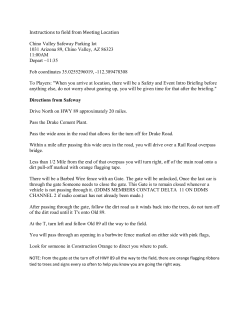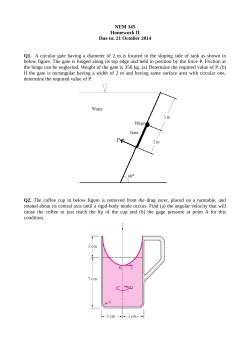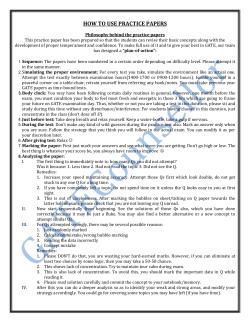
MOSFETS - Oregon State University
Metal Oxide Semiconductor Field Effect Transistors - MOSFETS The MOSFET is one type of a large number of transistor types. The MOSFET is the most widely used semiconductor device. To the first order, the MOSFET is a simple electronic switch that connects two of its terminals when a control voltage on a third terminal is high enough. The MOSFET’s name is derived from the key principle of its operation. That is, current through the device is controlled by an electric field. This is in contrast to other transistor types who control the flow of current through them via a electrical current. The MOSFET, functioning as a linear element can be thought of as as a dimmer switch. The basic idea is the same as the switch but with a more continuous operational state. Depending on the electric field at one terminal, the current allowed to flow between two other terminals is made variable. While actually having four terminals, for most applications, two of them are usually connected together. In this discussion, when we are looking at the MOSFET, we will be concerned with about three terminals; the gate, drain, and source. The gate is the control terminal where the electric field is applied. The drain and source are the terminals which carry the load current. 2N7000 Q1 d Ig = 0 g Id d g Ig=0 Vgs s Id s 2N7000 2N7000 Q1 Q2 d Figure 1: MOSFET Schematic Symbol and its Switch Model g 2N7000 Q1 Id The source terminal is common to thedvoltage applied at the gate and to the current flowIg =both 0 s g ing from the drain to the source. When acting as a switch, the MOSFET connects the drain to s Q3the gate and Q4 the source terminals with a low resistance when the voltage between source (Vgs ), BS250 BS250 is greater than the threshold voltage Vt . If sVgs is less than gthe threshold voltage, the resistance Vgs between the drain and source is very high. For N-channel MOSFET we will be discussing, the d current always flows from the drain towards the source. Q5 NFET Q6 PFET primarily digital symbols Several schematic symbols for a MOSFET are shown below. The symbols on the left give the most clear indication as to the operational characteristics of the device. On device Q1, the gate is not connected either electrically or symbolically to the body of the part but is separated by an insulting barrier. The top and bottom terminals, drain and source respectively, form a conditionally conductive channel as shown by a segmented path from drain to source. The body connection is the one with the arrow and is usually tied to the source terminal as we will soon see. The symbols in the center column are commonly used analog representations of the MOSFET where the fourth terminal may had an independent connection. 1 The symbols on the top row are N-Channel devices. The devices on the bottom row are P-Channel devices. These names come from the type of conductive channel that is formed in the MOSFET when an enabling voltage is placed on the gate. The right column of MOSFETS, Q5 and Q6, are primarily used in the digital realm. Q5 is an 2N7000 Q1 device and is turned on by having its gate at a logic one potential. Q6 however is a N-Channel d Id d Ig =P-Channel 0 device and on with a logic zero potential. Digital logic gate schematic symbols g g is turned Id regularly use the bubble to signify a input or output that is activated by a logic low potential. Ig=0 Vgs s s 2N7000 Q1 d 2N7000 Q1 d Ig = 0 g g s Q5 NFET Id s s Vgs 2N7000 Q2 g Q3 BS250 Q4 BS250 Q6 PFET d primarily digital symbols Figure 2: Common MOSFET Schematic Symbols Basic MOSFET Operation In figure 3 we see the physical structure of an N-Channel Enhancement mode MOSFET. The substrate of body of the transistor is made of p-type silicon formed from a single crystal. Two highly conductive n+ regions forming the source and drain, are created in the p-type silicon by bombarding the p-type silicon with atoms that supply extra electrons to the surrounding silicon atoms in the crystal lattice structure. A very thin later of silicon dioxide, SiO2 is grown on top of the substrate between the source and drain regions. On top of this insulating layer is deposited the metal gate region. Metal contacts are made to the source and drain regions as well as to the back side of the substrate. 2 source metal gate oxide (S:O2) drain metal n+ n+ p-type substrate channel region body Figure 3: MOSFET Physical Structure In figure 4 we see the side view of the MOSFET. It is helpful to see that the structure of the MOSFET closely resembles a MOS capacitor. The gate forms the upper plate that is insulted from the body by the thin oxide film. The p-type capacitor body and the highly conductive n+ region on the left provide the other terminal for the capacitor. If a positive charging potential is applied to the gate and a negative to the body/n+ terminal, free electrons from the body are drawn from the n+ area and fill the region under the gate. The numerous free electrons connected to the n+ region create the bottom plate of the capacitor. The abundance of electrons beneath the gate oxide essentially form a low resistance capacitor plate. 3 +++++++++ +++++++++ n+ ------------------ p-type +++++++++ +++++++++ n+ source n+ gate drain Figure 4: MOS Capacitor ------------------ p-type However, consider what could happen if another highly conductive n+ region is placed on the right side of the gate. If the gate potential is made sufficiently positive relative to the body/n+ terminal as before, the conductive channel underneath the gate would extend from the left n+ region to the right n+ region, forming a low resistance connection. This would be the MOSFET in n+ an on state. source pe body gate n+ drain n+ p-type body Figure 5: MOSFET Formed by Adding Source and Drain Terminals 4 Now, let’s look at the big picture. + - Vgs > VTn +++++++++ +++++++++ n+ ----------------------------------- + - Vds n+ n-type channel formed p-type Figure 6: MOSFET Conduction Channel Formed by Positive Gate If the gate potential is made sufficiently positive with respect to the body/n+ region, the free electrons will be attracted to the area directly under the insulator. These free electrons primarily come from the source n+ region. This is the origin of the MOSFET source terminal. The potential at which the conductive channel is formed is when Vgs > Vt . vt is also known as the threshold voltage. They fill the channel under the gate forming a n-type region within the p-type material. This action is called inversion. The number of electrons in the channel can be adjusted by the positive potential on the gate, thus varying the effective resistance of the channel from drain to source. If, as shown, the source is at the lower potential, electrons drawn from it flow through the channel and are drained to the higher potential of the power supply Vds. This gives the MOSFET drain terminal its name. Of course, we are speaking of electron flow here and not current flow. Conventional current flow is depicted in 6. If the positive potential is removed from the gate, the conductive channel disappears, becoming high resistance, and current can no longer flow between drain and source. 5
© Copyright 2025









